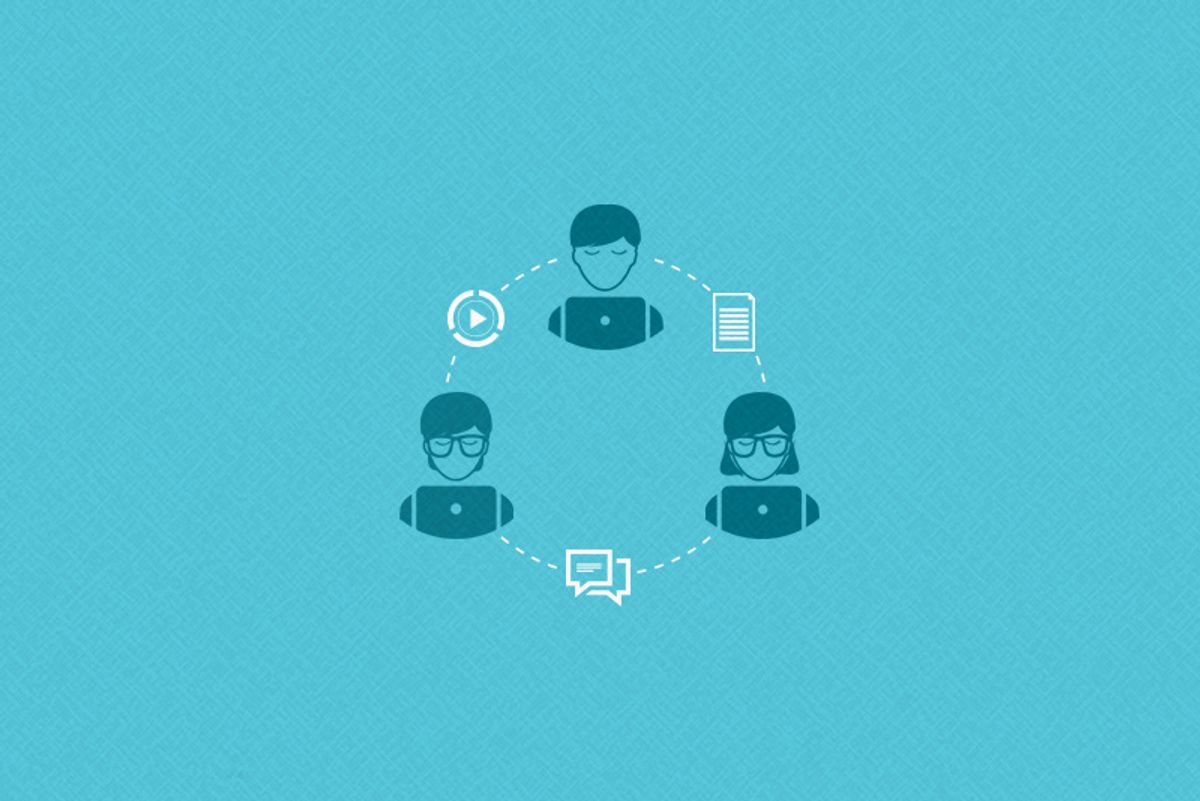A version of this article previously appeared on Skillcrush, an online education program for creatives, thinkers, and makers that gives total tech newbies the tools to make major career changes.
Scott Morris, Skillcrush
My entry into remote work was so out of the blue that I didn't have a lot of thoughts or opinions on the topic before I was hired. One day, a friend of mine at Skillcrush put out a call on Facebook about a job opportunity, and a few weeks later I was back in the workforce after 12 years away from paid work. Of course—since Skillcrush is a fully distributed company (meaning we all work remotely)—my return to work happened from my home here in Santa Rosa, CA.
For me, being able to work from home was a dream come true. Because a remote work situation fit so perfectly with what I'd been looking for—part time work that gave me the flexibility to keep up with my full-time, primary parenting duties—the benefits were obvious. I hadn't read a single article singing the praises of remote work, but I didn't need to—I was already sold. As I learned more about working remotely and interviewed people on the topic through my new job, I was surprised to learn that there were quite a few perceived downsides to remote work or aspects of distributed companies, that gave people pause.
One of the main concerns people seemed to have about the prospect of remote work, is the fear that working outside of a conventional office environment will simply be too lonely. This was a somewhat foreign concept to me, as my own entry to remote work was from a point where I was already home by myself for long stretches of time. But if you're approaching remote work from a more traditional office atmosphere, with water cooler talk and happy hours, it's true that there will be a significant change when you trade that in for a home office, or a public library, or a coffee shop, or any other location with Internet access. But that change can be as positive (or negative) as you want it to be.
From my own experience over this past year, I've found that remote work doesn't lead to isolation—regardless of your background. It's true that remote positions are different than working in a fully-staffed, brick and mortar office, but different doesn't have to mean lonely. In fact, despite its unfortunate name—remote work can provide you with a platform for making a whole new wealth of connections in your life, in ways that conventional work can't.
The caricature of a remote tech worker usually depicts a frenzied computer programmer alone in a poorly-lit room, hammering away at a keyboard late into the night. And while I've pulled some late nights myself to meet deadlines, specifically because my flexible schedule lets me work when it's convenient to the rest of my life, the isolated nature of this trope is a fallacy.
Remote workers don't exist in vacuums. We work with teams, for clients, for customers, and for companies—all arrangements that involve other people. Unlike conventional jobs, the people we work for and with, are literally positioned all over the world. From my own suburban perch here in Northern California I work with people as far-flung as my editors who live in Brooklyn, our Customer Support Manager who lives in Finland (by way of Texas), a WordPress developer who lives in Miami, and our Curriculum Director who lives down the street from me. In a conventional, physical workplace, this kind of diversity of lifestyle and perspective would be hard to replicate. Sure, there's always conference calls with clients or teams from out of area, but it's not the same as working virtually side-by-side with people from such varied locales on a daily basis.
And we really do work side-by-side! Remote work doesn't mean we operate individually in isolated pods. Anyone who's "at work" is logged into our company's HipChat room, and in a way it makes people seem more present than if we were scattered throughout a physical office. If someone is online and available, you know exactly where to find them, and—due to our geographical range and flexibility of work schedules—there's almost always someone else "in the building." Even when I'm working odd hours in my timezone, there's usually a co-worker or two an instant message away who I can bug with a meme or bad joke. It's our own version of water cooler talk.
But what might really surprise people who have yet to work on a remote team or for a distributed company, is how quickly and easily remote colleagues are able to go past the superficiality of small talk, and really get to know each other. Although it's counterintuitive— since we interact mostly through text, Zoom, and Google Hangouts—there's an immediacy to our remote connections that makes people want to open up, be themselves, and share their feelings and ideas freely.
Because we're only virtually face-to-face, and many of us won't ever meet in person, there's a need to cut past pretense and make our virtual work relationships seem more real. From my own perspective, I can say that I feel more connected to my remote colleagues after a period of months than I did after years in some cases at previous, conventional jobs. Part of it, too, goes back to our all being together in the same HipChat room. In a physical workplace it's possible to never see employees from a different department or who work in a different part of the building, but, in our distributed workplace, we're all swimming in the same pool of Giphy-fueled space. Because of that, I've struck up work friendships and acquaintances with people I don't even interface with professionally.
Looking back after a year of working remotely, I feel that remote work isn't an inherently lonely or isolating situation that needs to be alleviated with tips or tricks. Sure, without spending some time putting yourself out there proactively and making connections with your remote community, you will run the risk of feeling like you're on an island. But those same feelings of loneliness and isolation can happen in the middle of a crowded office. Where remote work does significantly differ from conventional office jobs is in its ability to provide connections for people who aren't in a position to take on in-person work, and who otherwise would be facing significant challenges of isolation.
In my own situation as an at-home parent who was looking to get back into the workforce, I actually found myself feeling totally isolated by the prospects of conventional work. On one hand, there was a part of me ready to add a job back to my life, but having to do so at the expense of my role as a parent brought its own feelings of loneliness and loss. Similarly, I imagine there are other people whose backgrounds and lifestyles present these kinds of challenges—for instance living outside the range of conventional employment hubs, or living with chronic illnesses that make it difficult to work traditional 9-5 office hours.
For people socially or physically left out of the conventional workforce, remote work is a viable arrangement. In that sense, remote work is a solution to isolation, and it's no surprise that this solution is a hallmark of the tech industry. At its heart, technology is all about connectivity. So much of tech centers around streamlining and facilitating the flow of information, which inevitably brings the participants in that flow closer together. Despite the stereotypes of screens cutting people off from one another or leading to ruinous spirals of antisocial behavior, technology has consistently been a driver in my own social and personal life.
I met my wife and several friends I still have today through our participation in pre-Internet online Bulletin Board System culture, and—contrary to our parents' concerns that we weren't spending enough time with "real people"—it doesn't get more isolation-busting than that. By adopting the remote work model, the tech industry continues this trend of bringing people closer together, whether or not they're anywhere near each other physically. When we talk about things like in-person tech meetups or jobs at companies that are geographically connected to tech hubs, it's easy to forget that this excludes groups of people who are physically isolated from these opportunities for various reasons. But with the ability to participate remotely we get closer to the ideal of everyone being welcome in tech, and it's hard to feel lonely with an invitation that inclusive.




